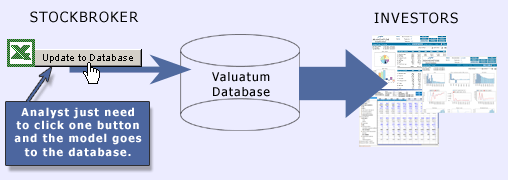|
Excel and Valuatum Platform
This page provides an overview of the role of Excel valuation
model in Valuatum Platform.
Excel and Valuatum Platform - overview
Valuatum Platform includes Excel valuation model, which
is the ultimate
starting point of the research number data. Analysts
modify their estimates in Excel and the data is transferred
from there to Valuatum database and from there onwards
to the investors. This happens with the help of Excel-formulas,
a macro and a java program.
In practice analysts only press "Update to database"
button whenever they want to transfer their new estimates
to the database. After that the system takes care of everything
else. Estimates go to investors in two minutes.

Establishing Excel and Valuatum Platform association
A new Valuatum Platform customer (Broker or any other
information provider delivering its research through Valuatum
Platform) has basicly two possibilites to create the association
between its Excel Valuation models and Valuatum Platform:
- Broker uses its current Excel valuation model and
it is integrated to Valuatum Platform. In practice
one sheet and some macros are added to Broker's current
Excel valuation models.
- The model has to include automatic year change -feature
in order to avoid manual changing of links and thereby
human errors within the process.
- Balancing assets and liablities should be automatic
- Update process of all the models in use should be
automatic in order to facilitate the operation with
the models.
- Broker adopts Valuatum's Excel valuation model
- The output-sheets and preliminary input sheets
of the broker stay as they have been before, only
model framework (model kernel, inform.flow framework)
in between those is changed.
- Automatic year change, balancing assets and liabilities,
automatic update (konversions) are solved already
and thus the links are not supposed to change with
human errors which enables flawless data.
Why to adopt Valuatum Excel model?
The characteristics of Valuatum Excel Valuation model,
briefly
- Automatic balancing of assets and liablities
as forecasts are changed.
- Automatic year-change function (only one click
needed to change year).
- Automatic procedures to updating models (all
the models can be updated at once with few clicks).
- Figures up to quarter and divisional levels in the
past and near future.
- Some alternative ways to estimate (e.g. Net sales
and EBIT can be inputted in absolute figures or as percentages
(net sales growth, ebit margin).
- Includes DCF- and EVA-statements which are integrated
to estimates and thus generate fair value based on current
estimates. DCF- and EVA-statements produce identical
fair value as the theory suggests.
- Broker can integrate both its own output sheets and
preliminary input-sheets easily to Valuatum Excel Valuation
Model
The characteristics of Valuatum Excel Valuation model,
in detail
- Automatic balancing of assets and liablities
as forecasts are changed.
As the user changes any estimates (growth, margins,
investments, net working capital etc.), the assets
and liabilities of course change and thus the original
equilibrium between assets and liabilities disappears.
The model however balances the situation automaticly:
it either increases or decreases liabilities or increases
or decreases cash. This mechanism and how to control
it is explained in detail in this
tutorial-document.
- Automatic year-change function (only
one click needed to change year).
As the fiscal year results are reported and thus
current year changes into history, the valuation models
have typically to be changed somehow: new current
year has to be estimated in detail and links have
to be changed to output sheets.
In Valuatum Excel model this procedure has been defined
to consist 245 different actions: changing of links,
copying formulas ahead, removing some very old information
(quarterly data older than 3 years, yearly data older
than 7 years) and things like that.
However the user does not have to do these changes
him-/herself. Every model includes a "YearChange"
macro that does all the necessary actions when
they are needed (as the company in question reports
its fiscal year). The running of this macro takes
about 10 seconds and all the analyst has to do is
press a button.
- Automatic procedures to updating models (all
the models can be updated at once with few clicks).
Each broker wants to update its Valuation models
from time to time as it wants to for example add new
figures or change the layout in output sheets. With
Valuatum model as the base this can be done by doing
the changes in just one Excel file, called empty model,
and then making a "conversion" with a Valuatum
macro workbook.
Conversion means that macro copies all the input-data
from an old model to the new empty model and. Then
the macro saves the new workbook and goes to the next
model and runs each one by one. This means that all
the old models can be converted into new models automaticly
and quickly (about one 20 seconds per model) and without
humane errors.
- Figures up to quarter and divisional levels in the
past and near future.
- Some alternative ways to estimate (e.g. Net sales
and EBIT can be inputted in absolute figures or as percentages).
- Includes DCF- and EVA-statements which are integrated
to estimates and thus generate fair value based on current
estimates. DCF- and EVA-statements produce identical
fair value as the theory suggests.
- Broker can integrate both its own output sheets and
preliminary input sheets easily to Valuatum Excel Valuation
Model.
 See
more information about using Valuatum Excel model: See
more information about using Valuatum Excel model:
Analyst Help pages
Excel-integration
|

















